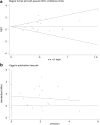Corticosteroid use and intensive care unit-acquired weakness: a systematic review and meta-analysis
- PMID: 30075789
- PMCID: PMC6091087
- DOI: 10.1186/s13054-018-2111-0
Corticosteroid use and intensive care unit-acquired weakness: a systematic review and meta-analysis
Abstract
Background: The association between corticosteroid use and intensive care unit (ICU)-acquired weakness remains unclear. We evaluated the relationship between corticosteroid use and ICU-acquired weakness in critically ill adult patients.
Methods: The PubMed, Embase, Web of Science, Cochrane Central Register of Controlled Trials, and Cumulative Index of Nursing and Allied Health Literature databases were searched from database inception until October 10, 2017. Two authors independently screened the titles/abstracts and reviewed full-text articles. Randomized controlled trials and prospective cohort studies evaluating the association between corticosteroids and ICU-acquired weakness in adult ICU patients were selected. Data extraction from the included studies was accomplished by two independent reviewers. Meta-analysis was performed using Stata version 12.0. The results were analyzed using odds ratios (ORs) and 95% confidence intervals (CIs). Data were pooled using a random effects model, and heterogeneity was evaluated using the χ2 and I2 statistics. Publication bias was qualitatively analyzed with funnel plots, and quantitatively analyzed with Begg's test and Egger's test.
Results: One randomized controlled trial and 17 prospective cohort studies were included in this review. After a meta-analysis, the effect sizes of the included studies indicated a statistically significant association between corticosteroid use and ICU-acquired weakness (OR 1.84; 95% CI 1.26-2.67; I2 = 67.2%). Subgroup analyses suggested a significant association between corticosteroid use and studies limited to patients with clinical weakness (OR 2.06; 95% CI 1.27-3.33; I2 = 60.6%), patients with mechanical ventilation (OR 2.00; 95% CI 1.23-3.27; I2 = 66.0%), and a large sample size (OR 1.61; 95% CI 1.02-2.53; I2 = 74.9%), and not studies limited to patients with abnormal electrophysiology (OR 1.65; 95% CI 0.92-2.95; I2 = 70.6%) or patients with sepsis (OR 1.96; 95% CI 0.61-6.30; I2 = 80.8%); however, statistical heterogeneity was obvious. No significant publication biases were found in the review. The overall quality of the evidence was high for the randomized controlled trial and very low for the included prospective cohort studies.
Conclusions: The review suggested a significant association between corticosteroid use and ICU-acquired weakness. Thus, exposure to corticosteroids should be limited, or the administration time should be shortened in clinical practice to reduce the risk of ICU-acquired weakness.
Keywords: Corticosteroid therapy; Corticosteroid use; Corticosteroids; ICU-acquired weakness; Intensive care unit; Systematic review.
Conflict of interest statement
Not applicable.
Not applicable.
The authors declare that they have no competing interests.
Springer Nature remains neutral with regard to jurisdictional claims in published maps and institutional affiliations.
Figures



References
-
- Hermans G, Van Mechelen H, Clerckx B, Vanhullebusch T, Mesotten D, Wilmer A, Casaer MP, Meersseman P, Debaveye Y, Van Cromphaut S, et al. Acute outcomes and 1-year mortality of intensive care unit-acquired weakness. A cohort study and propensity-matched analysis. Am J Respir Crit Care Med. 2014;190(4):410–420. doi: 10.1164/rccm.201312-2257OC. - DOI - PubMed
-
- Rhodes A, Evans LE, Alhazzani W, Levy MM, Antonelli M, Ferrer R, Kumar A, Sevransky JE, Sprung CL, Nunnally ME, et al. Surviving Sepsis Campaign: International Guidelines for Management of Sepsis and Septic Shock: 2016. Intensive Care Med. 2017;43(3):304–377. doi: 10.1007/s00134-017-4683-6. - DOI - PubMed
Publication types
MeSH terms
Substances
LinkOut - more resources
Full Text Sources
Other Literature Sources
Medical
Molecular Biology Databases

